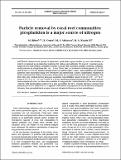Por favor, use este identificador para citar o enlazar a este item:
http://hdl.handle.net/10261/182012COMPARTIR / EXPORTAR:
 SHARE SHARE
 CORE
BASE CORE
BASE
|
|
| Visualizar otros formatos: MARC | Dublin Core | RDF | ORE | MODS | METS | DIDL | DATACITE | |

| Campo DC | Valor | Lengua/Idioma |
|---|---|---|
| dc.contributor.author | Ribes, Marta | es_ES |
| dc.contributor.author | Coma, Rafael | es_ES |
| dc.contributor.author | Atkinson, M.J. | es_ES |
| dc.contributor.author | Kinzie III, Robert A. | es_ES |
| dc.date.accessioned | 2019-05-22T10:37:24Z | - |
| dc.date.available | 2019-05-22T10:37:24Z | - |
| dc.date.issued | 2003 | - |
| dc.identifier.citation | Marine Ecology Progress Series 257: 13-23 (2003) | es_ES |
| dc.identifier.issn | 0171-8630 | - |
| dc.identifier.uri | http://hdl.handle.net/10261/182012 | - |
| dc.description | Este artículo contiene 11 páginas, 5 figuras, 4 tablas. | es_ES |
| dc.description.abstract | Removal and uptake of planktonic particulate organic matter by coral reef benthos is widely recognized as an important pathway for carbon and nutrients. We placed 3 natural assemblages of coral reef benthos, including 3 species of corals with associated sponges, ascidians, actinians, and bryozoans, in a long flume (24 × 0.4 × 0.3 m). Water was re-circulated at various speeds (5, 13, 22, and 32 cm s–1) over 6 h, and the disappearance of particles (pico-, nano-, microplankton and detrital particles) were measured using flow cytometry and microscopy. Control communities consisted of dead coral skeletons. Rates of removal of all particles were proportional to their concentrations. The first-order rate constant for the decrease in particle concentration ranged from 36 to 97 × 10–6 m s–1 (mean ± SD = 63 ± 16 × 10–6 m s–1), with 71% of this variation explained by particle type. Water velocity had no significant effect on these rate constants. Living particles contributed 96% of the total nitrogen removal, with picoplankton (cells 0.2 to 2 µm) accounting for 92%. Overall, nitrogen removal from particles (8.8 to 10.3 mmol N m–2 d–1) appears to be similar in magnitude to that of dissolved inorganic nitrogen; thus, picoplankton is a major source of nitrogen for these coral reef assemblages. | es_ES |
| dc.description.sponsorship | This paper was funded in part by the NOAA project #R/CR-1, which is sponsored by the University of Hawaii Sea Grant College Program, SOEST, under Grant #NA 86RG0041. Additional funding was provided by CISNet (NOAA project #NA 870A0531). | es_ES |
| dc.language.iso | eng | es_ES |
| dc.publisher | Inter Research | es_ES |
| dc.rights | openAccess | es_ES |
| dc.subject | Nutrients | es_ES |
| dc.subject | Particle removal | es_ES |
| dc.subject | Benthos | es_ES |
| dc.subject | Coral reef communities | es_ES |
| dc.title | Particle removal by coral reef communities: picoplankton is a major source of nitrogen | es_ES |
| dc.type | artículo | es_ES |
| dc.identifier.doi | 10.3354/meps257013 | - |
| dc.description.peerreviewed | Peer reviewed | es_ES |
| dc.relation.publisherversion | http://dx.doi.org/10.3354/meps257013 | es_ES |
| dc.identifier.e-issn | 1616-1599 | - |
| dc.relation.csic | Sí | es_ES |
| oprm.item.hasRevision | no ko 0 false | * |
| dc.type.coar | http://purl.org/coar/resource_type/c_6501 | es_ES |
| item.openairetype | artículo | - |
| item.cerifentitytype | Publications | - |
| item.grantfulltext | open | - |
| item.fulltext | With Fulltext | - |
| item.openairecristype | http://purl.org/coar/resource_type/c_18cf | - |
| item.languageiso639-1 | en | - |
| Aparece en las colecciones: | (ICM) Artículos (CEAB) Artículos | |
Ficheros en este ítem:
| Fichero | Descripción | Tamaño | Formato | |
|---|---|---|---|---|
| Coma 2003.pdf | 712,94 kB | Adobe PDF |  Visualizar/Abrir |
CORE Recommender
SCOPUSTM
Citations
74
checked on 05-may-2024
WEB OF SCIENCETM
Citations
70
checked on 25-feb-2024
Page view(s)
247
checked on 18-may-2024
Download(s)
134
checked on 18-may-2024
Google ScholarTM
Check
Altmetric
Altmetric
NOTA: Los ítems de Digital.CSIC están protegidos por copyright, con todos los derechos reservados, a menos que se indique lo contrario.
